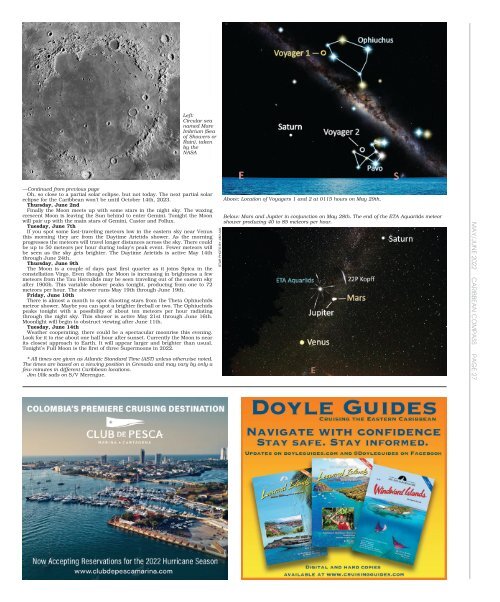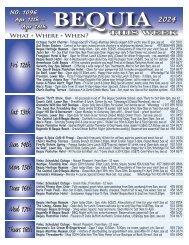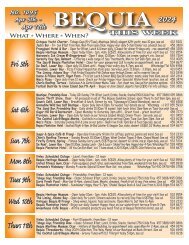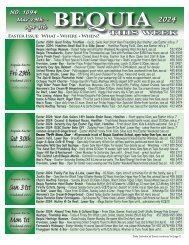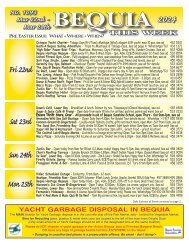Caribbean Compass Yachting Magazine - May/June 2022
Welcome to Caribbean Compass, the most widely-read boating publication in the Caribbean! THE MOST NEWS YOU CAN USE - feature articles on cruising destinations, regattas, environment, events...
Welcome to Caribbean Compass, the most widely-read boating publication in the Caribbean! THE MOST NEWS YOU CAN USE - feature articles on cruising destinations, regattas, environment, events...
You also want an ePaper? Increase the reach of your titles
YUMPU automatically turns print PDFs into web optimized ePapers that Google loves.
Left:<br />
Circular sea<br />
named Mare<br />
Imbrium (Sea<br />
of Showers or<br />
Rain), taken<br />
by the<br />
NASA<br />
— Continued from previous page<br />
Oh, so close to a partial solar eclipse, but not today. The next partial solar<br />
eclipse for the <strong>Caribbean</strong> won’t be until October 14th, 2023.<br />
Thursday, <strong>June</strong> 2nd<br />
Finally the Moon meets up with some stars in the night sky. The waxing<br />
crescent Moon is leaving the Sun behind to enter Gemini. Tonight the Moon<br />
will pair up with the main stars of Gemini, Castor and Pollux.<br />
Tuesday, <strong>June</strong> 7th<br />
If you spot some fast-traveling meteors low in the eastern sky near Venus<br />
this morning they are from the Daytime Arietids shower. As the morning<br />
progresses the meteors will travel longer distances across the sky. There could<br />
be up to 50 meteors per hour during today’s peak event. Fewer meteors will<br />
be seen as the sky gets brighter. The Daytime Arietids is active <strong>May</strong> 14th<br />
through <strong>June</strong> 24th.<br />
Thursday, <strong>June</strong> 9th<br />
The Moon is a couple of days past first quarter as it joins Spica in the<br />
constellation Virgo. Even though the Moon is increasing in brightness a few<br />
meteors from the Tau Herculids may be seen traveling out of the eastern sky<br />
after 1900h. This variable shower peaks tonight, producing from one to 72<br />
meteors per hour. The shower runs <strong>May</strong> 19th through <strong>June</strong> 19th.<br />
Friday, <strong>June</strong> 10th<br />
There is almost a month to spot shooting stars from the Theta Ophiuchids<br />
meteor shower. <strong>May</strong>be you can spot a brighter fireball or two. The Ophiuchids<br />
peaks tonight with a possibility of about ten meteors per hour radiating<br />
through the night sky. This shower is active <strong>May</strong> 21st through <strong>June</strong> 16th.<br />
Moonlight will begin to obstruct viewing after <strong>June</strong> 11th.<br />
Tuesday, <strong>June</strong> 14th<br />
Weather cooperating, there could be a spectacular moonrise this evening.<br />
Look for it to rise about one half hour after sunset. Currently the Moon is near<br />
its closest approach to Earth. It will appear larger and brighter than usual.<br />
Tonight’s Full Moon is the first of three Supermoons in <strong>2022</strong>.<br />
* All times are given as Atlantic Standard Time (AST) unless otherwise noted.<br />
The times are based on a viewing position in Grenada and may vary by only a<br />
few minutes in different <strong>Caribbean</strong> locations.<br />
Jim Ulik sails on S/V Merengue.<br />
STAR PHOTO BY JIM ULIK<br />
Above: Location of Voyagers 1 and 2 at 0115 hours on <strong>May</strong> 29th.<br />
Below: Mars and Jupiter in conjunction on <strong>May</strong> 28th. The end of the ETA Aquariids meteor<br />
shower producing 40 to 85 meteors per hour.<br />
MAY/JUNE <strong>2022</strong> CARIBBEAN COMPASS PAGE 27


